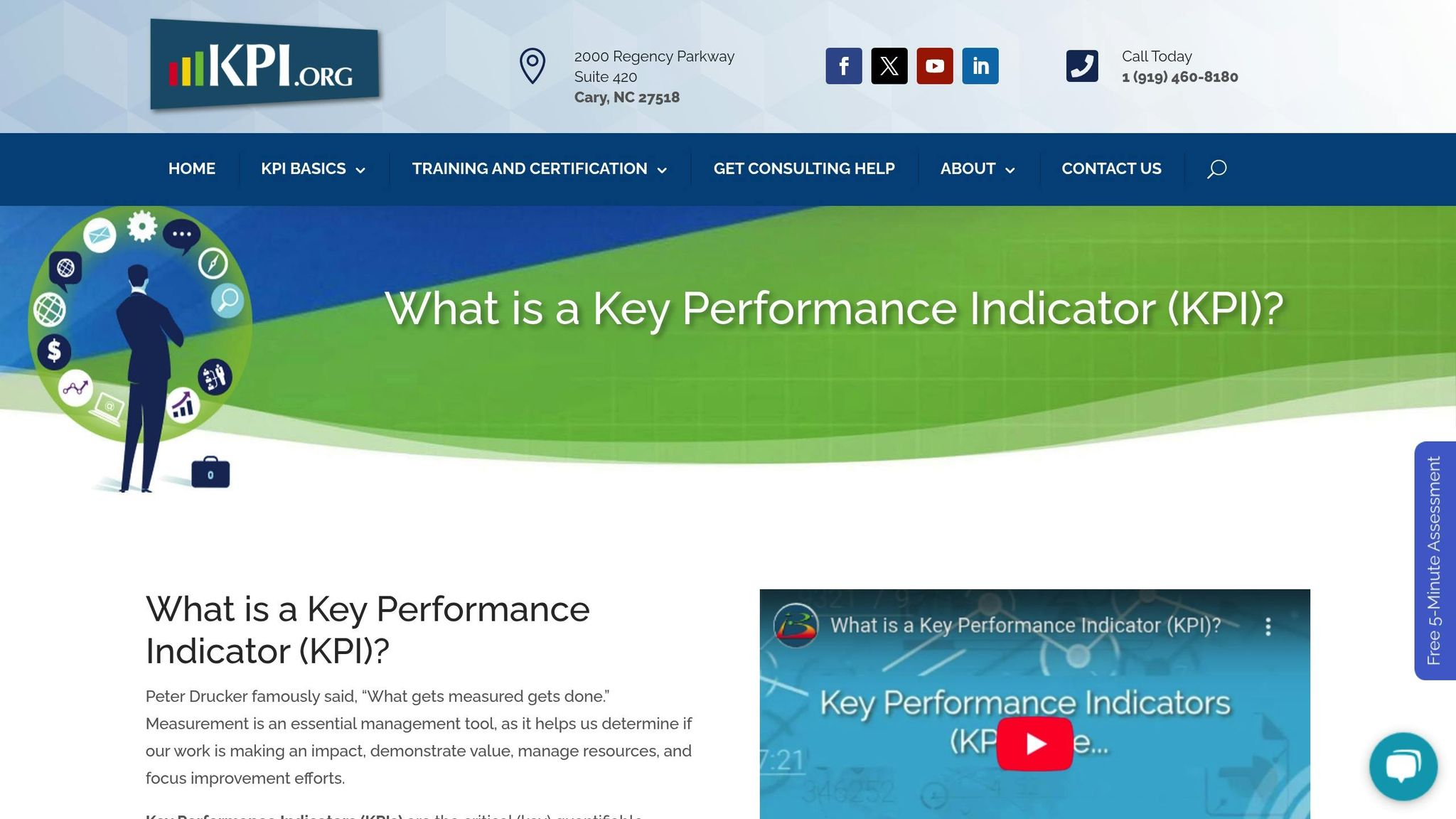AI-powered KPI dashboards make tracking and analyzing business performance faster, easier, and smarter. Here's how they help:
- Real-Time Updates: Automatically process and update data from multiple sources.
- Predictive Insights: Use historical data to forecast trends and risks.
- Smart Recommendations: Suggest immediate actions based on live metrics.
- Custom Dashboards: Tailor views to individual roles and priorities.
- Natural Language Commands: Ask questions or request data using plain language.
- Pattern Detection: Spot trends, outliers, and correlations in real time.
These features simplify decision-making, improve accuracy, and help businesses adapt quickly to market changes.
AI Features in KPI Dashboards

Automated Data Updates
AI-powered dashboards simplify data management with real-time KPI tracking and updates. These systems use advanced algorithms to automatically gather, process, and present data from various sources.
Here’s what they can do:
- Automatically clean and validate data
- Standardize data from multiple sources into uniform formats
- Detect anomalies or outliers that might indicate issues
- Instantly update visualizations as new data comes in
This smooth data integration ensures reliable information for tracking trends and making predictions.
Future Trend Forecasting
AI systems analyze historical data and external factors to create forecasts that help with planning. These include short-term, medium-term, and long-term projections, along with risk evaluations for different scenarios.
The algorithms continuously improve their predictions by learning from new data, making them more precise over time. This evolving accuracy helps businesses adjust their strategies to align with upcoming trends.
Custom Dashboard Creation
AI takes dashboard design to the next level by tailoring them to individual user needs. By analyzing user behavior and specific roles, it creates personalized interfaces that prioritize the most relevant KPIs for each team member.
This customization includes:
- Automatic dashboard adjustments based on user roles
- Dynamic layout changes driven by usage patterns
- Refinements that emphasize the most critical data
AI doesn’t just personalize layouts - it also highlights essential metrics and suggests new KPIs through:
- Smart visualizations for key data points
- Recommendations for additional KPIs based on user roles
- Improved access to the most important information
AI Tools for KPI Analysis
Pattern Detection
AI-driven pattern detection turns raw KPI data into meaningful insights. These systems monitor data streams constantly, spotting trends, anomalies, and correlations. By setting baseline performance metrics, they can quickly identify deviations that indicate potential issues or opportunities.
Key features of AI pattern detection include:
- Real-time tracking of data changes
- Recognizing seasonal patterns
- Providing early warnings for unusual activity
- Analyzing relationships between different metrics
Voice and Text Commands
AI makes accessing KPI data easier with natural language interfaces. Instead of dealing with complex queries, users can simply ask questions or type requests in plain language to get the information they need.
Examples of voice and text commands:
- "Show me last quarter's sales performance."
- "Compare current customer retention rates to last year."
- "Which KPIs are trending downward?"
- "Generate a report on inventory turnover."
The system processes these requests and delivers instant visualizations, simplifying the way businesses interact with their data.
Business Planning Tools
AI takes KPI insights further by supporting business planning. It helps generate scenarios, evaluate risks, optimize resources, and analyze budgets by leveraging historical data and external variables.
Capabilities include:
- Automatically creating scenarios based on past trends
- Assessing risks for different strategies
- Optimizing how resources are allocated
- Analyzing how budgets are affected by various factors
When choosing tools, look for features like:
- Seamless integration with existing data sources
- Customizable alerts for specific thresholds
- Mobile-friendly access
- Support for team collaboration and analysis
These AI tools transform raw KPI data into actionable strategies, giving businesses the insights they need to make smarter decisions.
Setting Up AI KPI Dashboards
Choosing Your KPIs
Pick KPIs that align with your business goals and can be improved through AI analysis. Focus on metrics that directly influence your outcomes.
Key factors to consider:
- Alignment with your business objectives
- Availability of consistent data
- Ability to track metrics in real-time
- Potential to provide actionable insights
For instance, in sales, you might track revenue alongside AI-powered metrics like customer lifetime value, sales cycle efficiency, purchase trends, and real-time conversion rates.
Connecting Data Sources
After defining your KPIs, connect the necessary data sources. Ensure the integration process is smooth while keeping data quality and consistency intact.
Steps to integrate data sources:
- Assess your current data sources
- Standardize data formats for uniformity
- Automate data pipelines, prioritizing security and scalability
- Set up validation checks to maintain accuracy
Pay attention to:
- API compatibility for seamless connections
- Frequency of data updates
- Robust data security measures
- Scalability to handle growth
Picking AI Software
With KPIs and data connections in place, select AI software that fits your needs and enhances your operations.
Key features to look for:
- Real-time data processing
- Customizable dashboards and visualizations
- Natural language processing tools
- Predictive analytics capabilities
Technical requirements to keep in mind:
- Cloud-based deployment for flexibility
- Mobile-friendly access
- Integration with existing systems
- Scalable design to accommodate future needs
Other practical considerations include:
- Time needed for implementation
- Ease of use for all team members
- Availability of technical support
- Options for future upgrades and enhancements
sbb-itb-f88cb20
How to Use AI to Generate Metrics and KPIs
Business Uses for AI Dashboards
AI dashboards are powerful tools that help businesses achieve better results by turning data into actionable insights.
Customer Retention Tracking
AI dashboards can help reduce customer churn by combining data into customer health scores, highlighting early warning signs.
Key metrics to track include:
- Engagement: Monitor user activity, feature usage, and interaction frequency.
- Support: Analyze ticket volume, resolution times, and satisfaction ratings.
- Purchase Behavior: Look at order frequency, cart abandonment, and spending habits.
- Risk Factors: Spot patterns like declining usage, late payments, or reduced engagement.
With these insights, you can:
- Set up alerts for sudden changes in customer behavior.
- Generate weekly reports to track engagement trends.
- Segment customers by risk levels.
- Measure the success of retention campaigns.
This data allows businesses to take proactive steps to improve customer loyalty.
Sales Performance Analysis
AI dashboards also enhance sales strategies by analyzing key data points, helping teams make smarter decisions.
Some features include:
- Pipeline Tracking: Monitor deal progress and pinpoint bottlenecks.
- Lead Scoring: Focus on prospects most likely to convert.
- Territory Management: Distribute workload and opportunities evenly.
- Revenue Projections: Forecast future sales using historical trends.
Important metrics to monitor:
- Win/loss ratios and deal speed by product, region, or sales rep.
- Customer acquisition costs and lifetime value.
- Productivity levels across the sales team.
By leveraging these insights, businesses can continuously refine their sales processes.
Operations Monitoring
Operational dashboards provide real-time insights, helping businesses identify inefficiencies and improve overall performance.
Key metrics to focus on:
- Supply Chain: Track inventory, supplier performance, and delivery times.
- Resource Use: Measure equipment efficiency and workforce productivity.
- Quality Control: Monitor defect rates and process adherence.
- Cost Management: Keep an eye on expenses and identify savings opportunities.
Features like real-time data integration, custom alerts, automated reports, and mobile access make it easier to respond quickly to operational challenges.
To get the most from your dashboards, regularly review and adjust metrics to align with changing business goals and market trends. Ensure your team understands how to interpret the data and use it to drive improvements across all areas of the business.
Wrapping It Up
AI-powered KPI dashboards are reshaping how businesses track, analyze, and act on performance data. By combining automation, predictive analytics, and real-time monitoring, these systems turn raw data into practical insights that drive smarter decisions.
Here’s how they make a difference:
Better Accuracy and Efficiency
- Automated updates in real-time reduce manual errors and speed up decision-making.
- Standardized reporting ensures consistency across teams.
- Ongoing data checks provide reliable insights.
Smarter Decision-Making
- Predictive analytics and pattern recognition highlight areas for improvement.
- Automated alerts encourage quick action when needed.
- Data-backed insights help guide long-term strategies.
Simpler, More Intuitive User Experience
- Dashboards are tailored to fit specific roles and needs.
- Natural language search makes finding data easier.
- Visual tools simplify complex trends and numbers.
These benefits help businesses make faster, more informed decisions.
To get the most from these dashboards, companies should:
- Match metrics to their current goals.
- Train teams to use the dashboards effectively.
- Keep data quality consistent and reliable.
- Provide a unified view of performance across departments.
In today’s data-heavy world, AI-powered KPI dashboards are a must-have for staying competitive and driving success. Their ability to deliver clear, actionable insights makes them a key tool for modern businesses.


